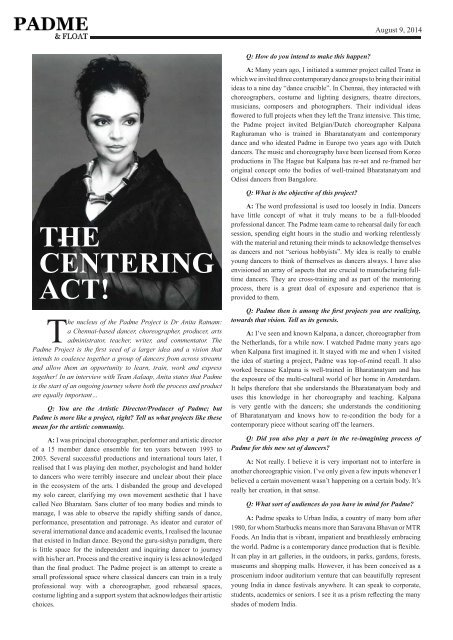COLLABORATORS
Create successful ePaper yourself
Turn your PDF publications into a flip-book with our unique Google optimized e-Paper software.
August 9, 2014<br />
Q: How do you intend to make this happen?<br />
A: Many years ago, I initiated a summer project called Tranz in<br />
which we invited three contemporary dance groups to bring their initial<br />
ideas to a nine day “dance crucible”. In Chennai, they interacted with<br />
choreographers, costume and lighting designers, theatre directors,<br />
musicians, composers and photographers. Their individual ideas<br />
<br />
the Padme project invited Belgian/Dutch choreographer Kalpana<br />
Raghuraman who is trained in Bharatanatyam and contemporary<br />
dance and who ideated Padme in Europe two years ago with Dutch<br />
dancers. The music and choreography have been licensed from Korzo<br />
productions in The Hague but Kalpana has re-set and re-framed her<br />
original concept onto the bodies of well-trained Bharatanatyam and<br />
Odissi dancers from Bangalore.<br />
Q: What is the objective of this project?<br />
THE<br />
CENTERING<br />
ACT!<br />
The nucleus of the Padme Project is Dr Anita Ratnam:<br />
a Chennai-based dancer, choreographer, producer, arts<br />
administrator, teacher, writer, and commentator. The<br />
<br />
intends to coalesce together a group of dancers from across streams<br />
and allow them an opportunity to learn, train, work and express<br />
<br />
is the start of an ongoing journey where both the process and product<br />
are equally important…<br />
Q: You are the Artistic Director/Producer of Padme; but<br />
Padme is more like a project, right? Tell us what projects like these<br />
mean for the artistic community.<br />
A: I was principal choreographer, performer and artistic director<br />
of a 15 member dance ensemble for ten years between 1993 to<br />
2003. Several successful productions and international tours later, I<br />
realised that I was playing den mother, psychologist and hand holder<br />
to dancers who were terribly insecure and unclear about their place<br />
in the ecosystem of the arts. I disbanded the group and developed<br />
my solo career, clarifying my own movement aesthetic that I have<br />
called Neo Bharatam. Sans clutter of too many bodies and minds to<br />
manage, I was able to observe the rapidly shifting sands of dance,<br />
performance, presentation and patronage. As ideator and curator of<br />
several international dance and academic events, I realised the lacunae<br />
that existed in Indian dance. Beyond the guru-sishya paradigm, there<br />
is little space for the independent and inquiring dancer to journey<br />
with his/her art. Process and the creative inquiry is less acknowledged<br />
<br />
small professional space where classical dancers can train in a truly<br />
professional way with a choreographer, good rehearsal spaces,<br />
costume lighting and a support system that acknowledges their artistic<br />
choices.<br />
A: The word professional is used too loosely in India. Dancers<br />
have little concept of what it truly means to be a full-blooded<br />
professional dancer. The Padme team came to rehearsal daily for each<br />
session, spending eight hours in the studio and working relentlessly<br />
with the material and retuning their minds to acknowledge themselves<br />
as dancers and not “serious hobbyists”. My idea is really to enable<br />
young dancers to think of themselves as dancers always. I have also<br />
envisioned an array of aspects that are crucial to manufacturing fulltime<br />
dancers. They are cross-training and as part of the mentoring<br />
process, there is a great deal of exposure and experience that is<br />
provided to them.<br />
<br />
towards that vision. Tell us its genesis.<br />
A: I’ve seen and known Kalpana, a dancer, choreographer from<br />
the Netherlands, for a while now. I watched Padme many years ago<br />
<br />
the idea of starting a project, Padme was top-of-mind recall. It also<br />
worked because Kalpana is well-trained in Bharatanatyam and has<br />
the exposure of the multi-cultural world of her home in Amsterdam.<br />
It helps therefore that she understands the Bharatanatyam body and<br />
uses this knowledge in her choreography and teaching. Kalpana<br />
is very gentle with the dancers; she understands the conditioning<br />
of Bharatanatyam and knows how to re-condition the body for a<br />
contemporary piece without scaring off the learners.<br />
Q: Did you also play a part in the re-imagining process of<br />
Padme for this new set of dancers?<br />
A: Not really. I believe it is very important not to interfere in<br />
another choreographic vision. I’ve only given a few inputs whenever I<br />
believed a certain movement wasn’t happening on a certain body. It’s<br />
really her creation, in that sense.<br />
Q: What sort of audiences do you have in mind for Padme?<br />
A: Padme speaks to Urban India, a country of many born after<br />
1980, for whom Starbucks means more than Saravana Bhavan or MTR<br />
Foods. An India that is vibrant, impatient and breathlessly embracing<br />
<br />
It can play in art galleries, in the outdoors, in parks, gardens, forests,<br />
museums and shopping malls. However, it has been conceived as a<br />
proscenium indoor auditorium venture that can beautifully represent<br />
young India in dance festivals anywhere. It can speak to corporate,<br />
<br />
shades of modern India.


